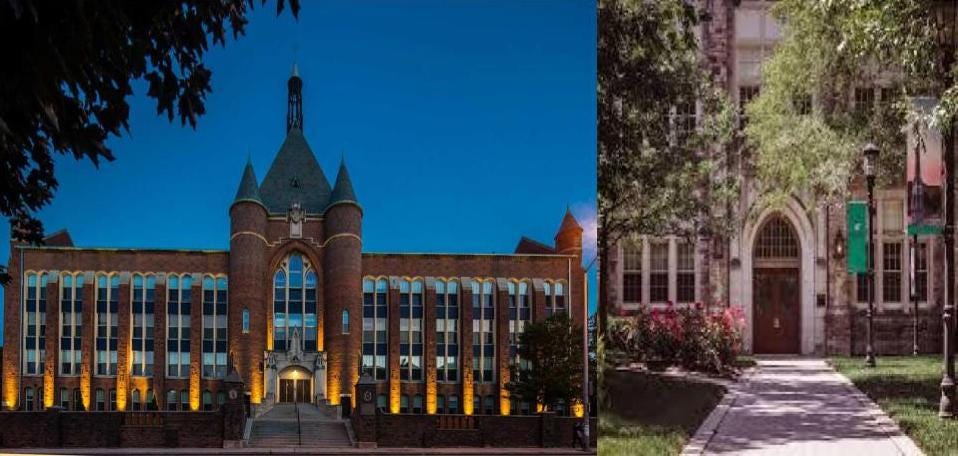Loyola University Maryland, A High School In Reality
Never have I been at a university designed more like a high school than Loyola

I was 11 or 12 when I first read about Princeton University’s infamous eating clubs in The World Book Encyclopedia in 1981 or 1982. I was so hungry that the idea of eating clubs at an Ivy League institution made me think of college as a place where I could eat an endless buffet while getting the education I needed to stay out of poverty as an adult. It was only in the mid-1990s as a PhD candidate at Carnegie Mellon when I learned what these eating clubs really were. Private social clubs for the richest among the already wealthy juniors and seniors, places to initiate and to build and deepen friendships and professional networks. If the food was any better than in the other eating halls, the books I read in 1995 didn’t say. But as someone who taught and lived on Princeton’s campus for two summers in the 2000s, I can say that the cafeteria food wasn’t bad, but the Frist student union food was almost bistro quality.
The cliques that obviously still exist in the Ivies also can and do exist at less prestigious universities. Some have layers of ultra-rich elitism, worlds inside worlds inside worlds, where efforts at racial, gender, and socioeconomic diversity go to die. And some universities lean into these social hierarchies, making them function more like private high schools than a four-year college or university.
Loyola University Maryland is mostly the latter, a Catholic high school much more than anything I’ve seen anywhere (I taught at Duquesne University in 1998-1999 and have guested at Georgetown a few times over the years, so…). Loyola possesses almost none of the intellectual diversity that made the University of Pittsburgh, my undergraduate alma mater and its commuter-school, Wonder-Bread-whiteness more bearable. (I really don’t care how US News & World Report ranks Loyola, given that schools pay to be in the ranking in the first place). So many of the 450 or so students I’ve taught over the past two years were either Division I student-athletes or part of Loyola’s sports clubs. I have come to suspect these clubs function in many ways like the eating clubs did at Princeton back in the day, a social status separator between the students who are among the rank-and-file and those committed to athletics, though themselves not on an athletic scholarship.
The course schedule at Loyola revolves around those students committed to athletics and these sports clubs. Many teaching faculty at Loyola teach two, three, even four consecutive classes with only ten-minute breaks in between and little or no time for anything else. Even at University of Maryland Global Campus (née University of Maryland University College), where I frequently complained about the high school-level of the college curriculum during my 15 years there, the university didn’t treat its adult learners like they were still teenagers. The history department and other departments offer courses during regular business hours, with few hybrid and online-only courses, or true evening or weekend classes. The university has lots of overworked professors with little say over their own teaching schedule, like high school teachers, but minus the protections of a union.
At Loyola, I have had students all too frequently ask if they could go to the bathroom, from first-years to seniors. I’ve had to publicly stop students from disrupting class in their attempts to be class clowns. I’ve had to explain to students why they couldn’t eat a three-course meal during a class. So many of them have sent me doctor’s notes to explain missing a class. I have even seen these students cut a line at the Starbucks in the student union. It’s no surprise I started having flashbacks to high school and the 1980s.
My colleagues have also conformed to their role as high school teachers. Just these last few weeks, I have seen teaching behaviors closer to what I experienced in middle school or before I started taking Advanced Placement courses in high school. In an adjacent classroom a couple of weeks ago, one professor had his students take an open laptop test. Only, with their backs turned to the front of the classroom, so that the professor could see every student’s laptop screen, I guess as an effort to prevent any cheating. (Anyone ever heard of a paper-based exam?)
That same week, I came into my classroom after lunch to find a three-page instruction sheet for a final exam from a classics course. The entire instruction sheet was terse and sarcastic. But the worst part included sections like “[i]f you do not bring your completed essay — typed, of course — you can’t receive the rest of the exam…you flunk the course” and “[n]o one will be permitted to leave the room during the test.” Shit! Even proctors for ETS on the SAT and AP exams allow students to go to the bathroom or to get a drink of water. “This is truly high-school ridiculous,” I said as I read these instructions to one of my students before I started my own class. “It’s also ableist and discriminatory. ‘Go to the bathroom beforehand’? Wow! Just, Wow!,” I continued. What did this professor think? That two students would take a bathroom break around the same time and exchange notes as part of a cheating conspiracy? If this isn’t high-school thinking, then I’m John Brown.
I know that despite the past three years, between American University and Loyola, I am not burned out. I am weary, a bit more impatient, and in desperate need of a vacation. But I am not in burnout mode. I would quit before demeaning my own students in the ways typical of high school thinking. But that’s college life at Loyola University Maryland, or really, expensive high school life for college-age students.





